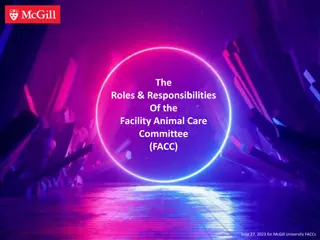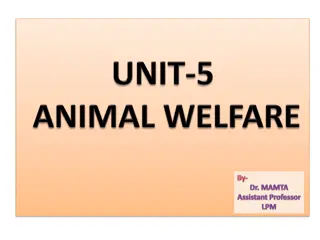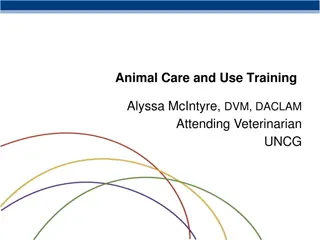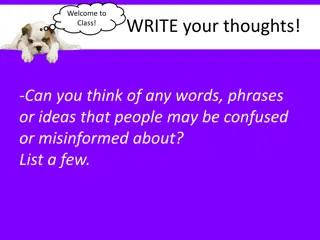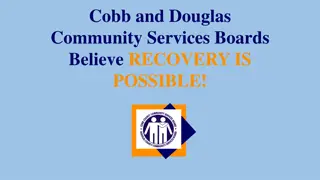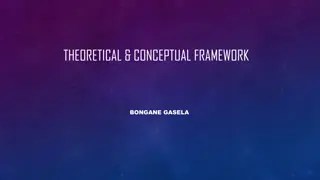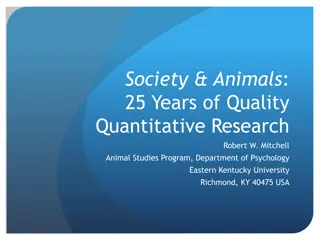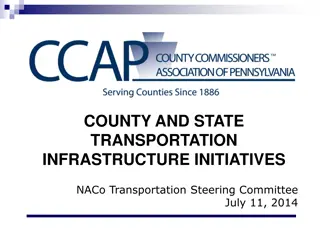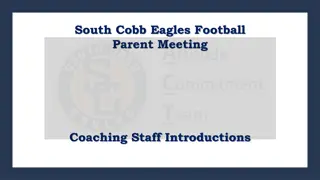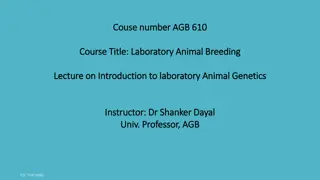Theoretical Evaluation: Cobb County Animal Control Analysis
The case of Cobb County Animal Control is analyzed through theoretical frameworks such as McGregor's X/Y Theory, bureaucratic authority, and Tom Burns and G.M. Stalker's Mechanistic Model. The organizational structure, animal statistics, and recommendations for employee management are discussed in detail.
Download Presentation

Please find below an Image/Link to download the presentation.
The content on the website is provided AS IS for your information and personal use only. It may not be sold, licensed, or shared on other websites without obtaining consent from the author.If you encounter any issues during the download, it is possible that the publisher has removed the file from their server.
You are allowed to download the files provided on this website for personal or commercial use, subject to the condition that they are used lawfully. All files are the property of their respective owners.
The content on the website is provided AS IS for your information and personal use only. It may not be sold, licensed, or shared on other websites without obtaining consent from the author.
E N D
Presentation Transcript
Theoretical Evaluation: The Case of Cobb County Animal Control By Lydia Weathers
Department of Public Safety Director: Jack L. Forsythe CCAC Organizational Structure Assistant Director: Capitan Van Hoozer Unit Manager: Lt. Shepard Shelter Operations (1) Veterinarian (1) Fiscal Technician (1) Field Operations (1) Animal Control Supervisor (1) Animal Control Supervisor (1) Animal Control Dispatcher (1) Veterinarian Technician (1) Animal Control Supervisor (1) Animal Control Supervisor (1) General Crew Chief (1) Friont Office Animal Control Officer I (8) Animal Control Officer II (1) Part-Time Dispatcher (1) Vacant Animal Care Specialists (1) Animal Care Specialists (1) Part-Time Kennel Technician (1) Animal Control Technician (1) Animal Control Officers I (6) Animal Control Officer I (6) Animal Control Officer II (1) Animal Control Assistant (2) Animal Control Officer I (6) Part-Time Animal Control Assistant (2)
CCAC Animal Statistics 2010: 5,150 adopted 1,460 reclaimed 5,447 dogs and cats euthanized 13,018 dogs, cats and wildlife impounded 2011 1,362 reclaimed 4,001 adopted 1,072 transferred to rescues 4,521 euthanized 12,721 dogs, cats and wildlife impounded
Theoretical Analysis: Douglas McGregor s X/Y Theory Y: enjoy working, self disciplined, seek advancement X: do as little as possible, require constant supervision, lack initiative McGregor suggestions: 1) Treat employees as mature adults 2) Provide advancement opportunities 3) Reduce micromanagement 4) Allow employees the opportunity to take ownership of their assigned areas 5) Promote employee self-confidence, self worth 6) Recognize that all employees, especially lower ranked employees as valuable assets
Works best in stable conditions Bureaucratic authority base Hierarchy of authority Vertical communication Written rules and regulations Clear instructions noting organizational objectives and expectations Stability of authority Specialization of tasks Scope of job Supports top-down decision making authority, communication, and implementation Advantages: Theoretical Analysis: Tom Burns and G.M. Stalker s Mechanistic Model Formal job descriptions Clear lines of authority Formal organizational rules and regulations CCAC
Theoretical Analysis: Pfeffer and Salanciks External Control of Organizations Resource Dependence Perspective CCAC Receives funding from Cobb County s General Fund General Fund receives revenue from property taxes State of economy affects acquisition of resources Organizations are dependent upon the successful and ongoing acquisition of resources
Theoretical Analysis: In Henry Mintzbergs The Power Game and the Players Organizations are not an island unto itself Many factors influence organizational decisions and actions Internal influencers Fulltime employees verbal imputes, decisions, and actions influence organizational goals and outcomes Example: staff meetings to discuss management/employee grievances External influencers General public (nonemployees) critiques public services, complains to public officials, thus affecting an organizations future decisions and actions. Example: Citizen complaint to the Board of Commissioners regarding animal control s inability to capture a large number of stray animal in their neighborhood. As a result, CCAC will reorganize its employees in-house shelter duties, thus assigning more officers to road duties instead of shelter management.
S.W.O.T. Authoritative and fair leadership Positive community relationship Strengths X Theory employees and rule violations Political process and spay/neuter clinic Weaknesses Opportunities Support system for employees Threats Rule enforcement inconsistency
Recommendations and Limits of Study Hire more kennel staff Not generalizable Retraining classes for rule violators Time restriction Creating support systems for employees
Adopt a Homeless Pet Today Office.com clipart
Bibliography Atlanta Boxer Rescue. (2013) Boxerstock. October 20. http://www.boxerstock.org/ (accessed November 29, 2013). Bardach, Eugene. (2012). A Practical Guide for Policy Analysis: The Eightfold Path to More Effective Problem Solving. 4. Los Angeles: CQ Press and Sage Publishing. Burns, Tom, and G.M.Stalker. (1961). "Mechanistic and Organic Systems ." In Classics of Organization Theory, by Shafritz Jay M, J. Steven Ott, & Yong Suk Jang, 201-205. Boston: Wadsworth. Cobb County County Government. (2013) Cobb County 2013-2014 Biennal Budget. September 30. https://ted.cviog.uga.edu/financial- documents/system/files/budget_docs/Cobb%20County%20FY2013.2014%20Budget.pdf (accessed November 23, 2013). Cobb County Government. (2011). Cobb County 2011-2012 Biennial Budget. September 30. https://ted.cviog.uga.edu/financial- documents/system/files/budget_docs/Cobb%20County%20FY2011.2012%20Budget.pdf (accessed November 23, 2013). . (2013).Cobb County Animal Control. Department of Public Safety. http://portal.cobbcountyga.gov/index.php?option=com_content&view=article&id=332&Itemid=486 (accessed November 20, 2013). . (2013). Cobb County Board of Commissioners and City Managers. Cobb County Government. http://portal.cobbcountyga.gov/index.php?option=com_content&view=article&id=39&Itemid=156 (accessed November 21, 2013). Cobb County Government. (2013). Human Resources. Cobb County Government. http://portal.cobbcountyga.gov/index.php?option=com_content&view=article&id=190&Itemid=189 (accessed November 21, 2013). . (2013). Human Resources Benefits Package. Cobb County Government. http://www.houze.org/index.php/cobb_county_government (accessed November 21, 2013). Cobb County Municipal Code. (1996). Chapter 10: Animals. MUNICODE. http://library.municode.com/index.aspx?clientId=10572 (accessed November 20, 2013). Fournier, Angela K., and E. S. Geller. (2004). Behavior Analysis of Companion-Animal Overpopulation: A Conceptualization of the Problem and Suggestions for Intervention." Behavior & Social Issues 13, no. 1, 51-68. Frank, Joshua M., and Pamela L. Carlisle-Frank. (2007). Analysis of programs to reduce overpopulation of companion animals: Do adoption and low-cost spay/neuter programs merely cause substitution of sources? Ecological Economics 62, no. 3-4, 740-746. Georgia House Rabbit Society. (2013). Spring Adopt-A-Thon In Cobb County. Georgia House Rabbit Society. http://www.houserabbitga.com/?p=7026 (accessed November 29, 2013). Good, Dr. (2012). Homeless Pets Clubs. Homeless Pets Foundation. http://www.homelesspets.com/pet-clubs/ (accessed November 21, 2013). Lee, Robert D., Ronald W. Johnson, and Philip G. Joyce. (2013). Public Budgeting Systems. 9. Burlington: Jones and Bartlett Learning. McGregor, Douglas Murry. (1957). The Human Side of Enterprise. In Classics of Organizational Theory, by Jay M. Shafritz, J. Steven Ott, & Yong Suk Jang, 183-188. Boston: Wadsworth. Millios, Bill. (2012). A Community Comes Together to Save Homeless Animals: The New Hampshire Story. Shelter Overpopulation Solutions (http://www.shelteroverpopulation.org/). http://www.youtube.com/watch?feature=player_embedded&v=_25WtHGRhII (accessed November 21, 2013). Mintzberg, Henry. (1983). The Power Game and the Players. In Classics of Organization Theory, by Jay M. Shafritz, J. Steven Ott, & Yong Suk Jang, 330-337. Boston: Wadsworth. Municode Ch.10; Art.2; Div.2. (1996). Animal Control Board. Municode. http://library.municode.com/index.aspx?clientId=10572 (accessed November 21, 2013). Petfinder.com. (2013). Friends of Shelter Animals for Cobb County. Petfinder.com. http://www.petfinder.com/pet-search?query_id=45B2C096-5977-11E3-B523- A03E28E17495&page_number=7 (accessed November 29, 2013). Petsmart Charities. (2013). Spay and Neuter Grants. Petsmart Charities. 2013. http://www.petsmartcharities.org/pro/grants/spay-neuter (accessed November 21, 2013). Pfeffer, Jeffery, and Gerald R Salancik. (1978). External Control of Organizations: A Resource Dependence Perspective. In Classics of Organizational Theory, by Jay M. Shafritz, J. Steven Ott, & Yong Suk Jang, 449-460. Boston: Wadsworth. Road Trip Home. (2012). Road Trip Home: about. Road Trip Home. http://www.roadtriphome.org/page0/ (accessed November 21, 2013). Sawicki, Beth. (2012). Cobb County Animal Control hosting pet Adopt-a-Thon. Marietta 11 Alive.com. September 28, 2012. http://marietta.11alive.com/news/events/138313-cobb-county-animal-control-hosting-pet-adopt-thon (accessed November 29, 2013). Spot Society. (2010). Metro Atlanta Animal Control Statistics 2010 Statistical Calculations. Spot Society. Org. http://www.spotsociety.org/~spotsoci/images/PDF/2010_ShelterStats.pdf (accessed November 23, 2013). . (2011). Metro Atlanta Animal Control Statistics 2011 Statistical Data.Stoping Pet Overpopulation Together. http://www.spotsociety.org/images/PDF/2011_ShelterStats.pdf (accessed November 23, 2013). Weber, Max. (1992). Bureaucracy. In Classics of Organizational Theory, by Jay M. Shafritz, J. Steven Ott, & Yong Suk Jang, 77-82. Boston: Wadsworth, 1922. O O O O O O O O O O O O O O O O O O O O O O O O O O O





